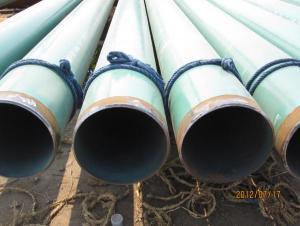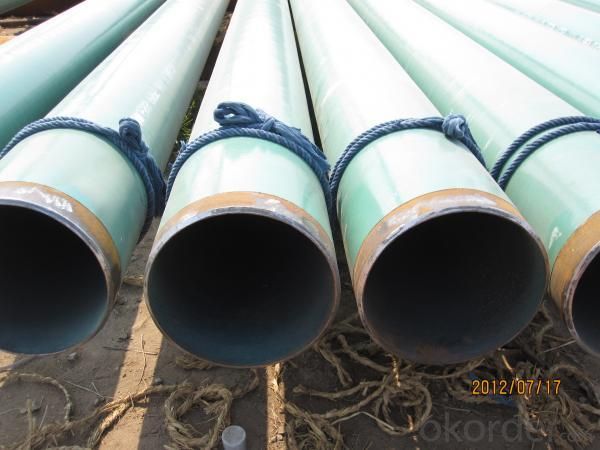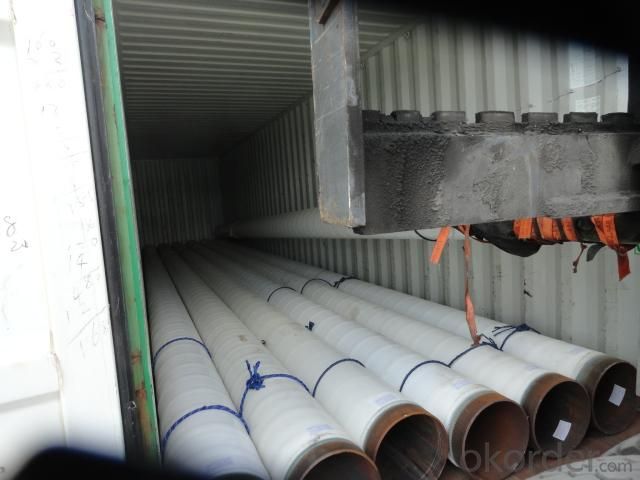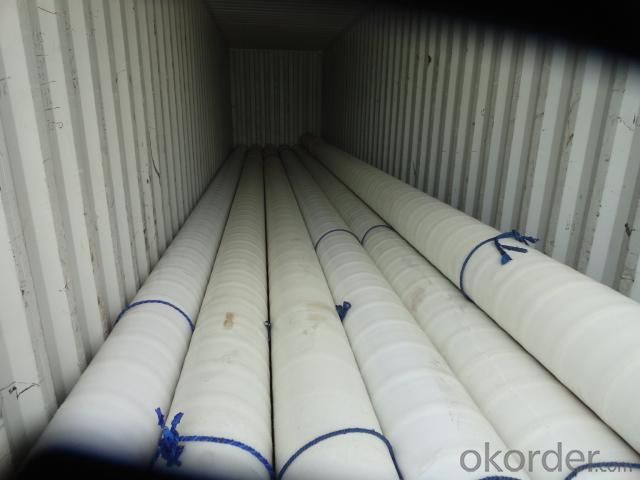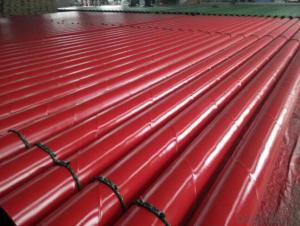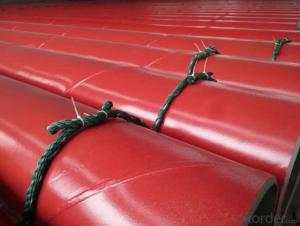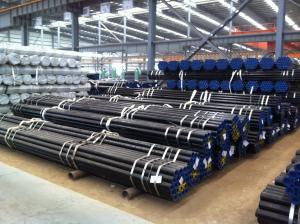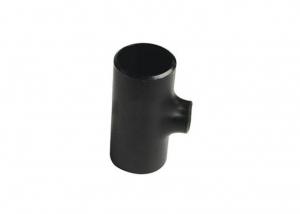2PE/3PE External Coating Steel Pipe
- Loading Port:
- Tianjin Port
- Payment Terms:
- TT or LC
- Min Order Qty:
- 50MT m.t.
- Supply Capability:
- 5000 Tons Per Month m.t./month
OKorder Service Pledge
OKorder Financial Service
You Might Also Like
Good price of 2PE/3PE External Coating ,ERW with good quality.
Quick details of 2PE/3PE External coating steel pipes,
|
order |
item |
performance |
test method. | |
|
2PE |
3PE | |||
|
1 |
peeling strength (N/cm)20±5℃ 50±5℃ |
≥35 ≥25 |
≥60 ≥40 |
DIN30670 |
|
2 |
cathodic disbanding(mm) (65℃,48h) |
≤15 |
≤10 |
SY/T4013 |
|
3 |
impact strength (J/mm) |
≥8 |
DIN30670 | |
|
4 |
bending resistant (2.5°) |
No cracking of polyethylene |
SY/T4013 | |
|
5 |
Pinhole (25kv) |
No leak |
DIN30670 | |
Specifications of 2PE/3PE External Coating Steel Pipe,
With chemical composition and mechanical properties analysis;hydrostatic test,dimensional and visual inspection,
also with nondestructive inspection.
Packing
1).Bundles or bare, each bundles with 8 steel strips and nylon slings wrapped with water proof plastic cloth.
2).We also pack our products according to customer’s requirement.
Main market:Middle east,East and west Europe, South and Southeast Asia, Africa,
MOQ:20T or as customers' requirement.
Supply ability:10,000T/M or according to practical situation.
Trade terms:FOB,CIF,CFR
Payment terms:T/T or L/C
Delivery Time:20-30 days after receiving the deposit or L/C at sight.
Port:Tianjin ,China
Application
1).Construction Hall Structure, Sea Trestle, Airport Structure, Shipbuilding, Security Door Frames, Garage
Doors,Strengthening Liners of Steel Doors and Windows, Indoor Partition Walls, Cable Bridge Structures and
Expressway Safety Guards, Balustrade, Decorating, Residential, Ornamental Pipes
2).Agriculture Agricultural Equipment
3).Industry Machinery, Solar Stent, Offshore Oil Field, Mine Equipment, Electromechanical Hardware, ,
heavy engineering, Mining and Resources, Process Engineering, Materials Handling,Mechanical Parts
4).Traffic Walking Rails, Roll-up Doors, Guardrail, Plaza Structure, Signage, Road Furniture, Fencing
Logistics Storage Supermarket Shelves, Containers,Transport Industries, Commercial Construction
Other Sports Apparatus, Leisure Equipment, Furniture, School Furniture
5).Material Storage Racks, Pallets, Hydraulic Platforms, Trusses, Columns, Purlins, Greenhouse Stands Towers
Advantages
1.We also can oil and paint the steel pipe
2.We can do special orders as your request
3.Provide other steel pipe: cold rolled,hot rolled,hot dipped,ERW pipe,etc.
4.We sincerely hope to establish long-term business relationship with you.
Services:
1.Reply your inquiry in 24 working hours.
2.Customized design is available. OEM service is welcome.
3.Special discount and protection of sales are provided to our customer.
4.We are manufacturer, specializing in producing all kinds of steel pipes for more than 20 years,
competitive with good quantity.
5.Sample: We can send out sample for test in one week if the order quantity is big enough. But the
shipment charges is usually paid by your side, the charges will be rebounded when we have formal order.
6.As an honest seller, we always use superior raw material, advanced machines, skilled technicians to ensure
our products to be finished in high quality and stable feature. Welcome to contact us or visit our company.
Picturers of 2PE/3PE External Coating Steel Pipe,
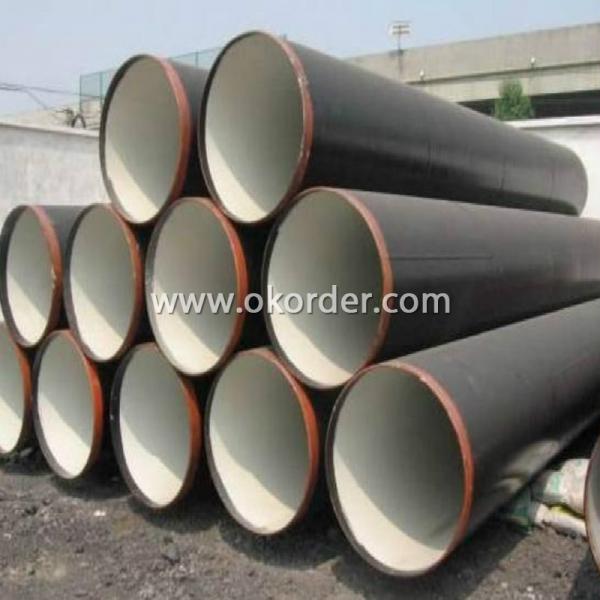
Finished coating ERW ,placed in factory.
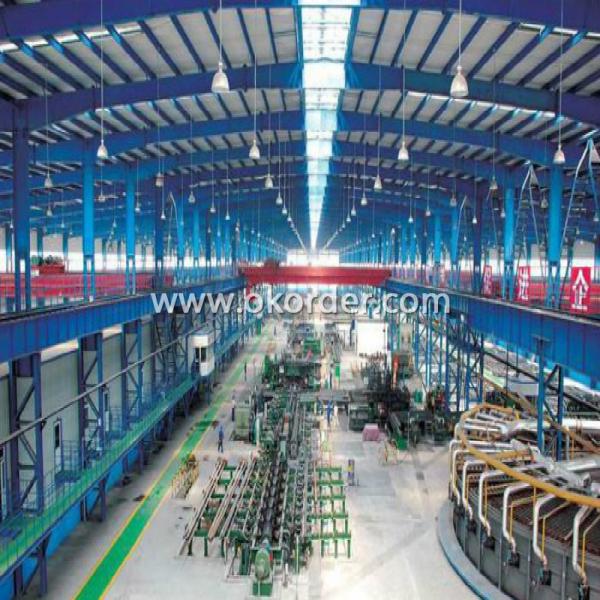
Advanced technology with imported equipment to ensure good quality.
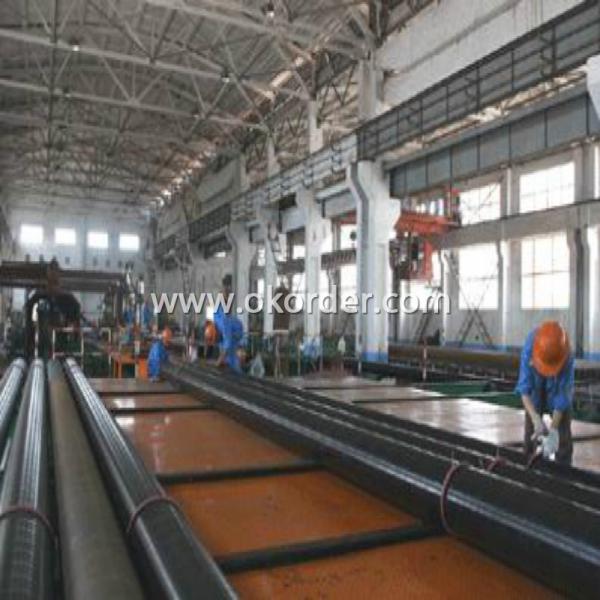
Professional and experienced staff do quality control.
We are manufacturer, specializing in producing all kinds of steel pipes for more than 20 years,
competitive with good quantity.
Welcome to order 2PE/3PEexternal coating steel pipe from us.
- Q: How are steel pipes used in the construction of wastewater treatment plants?
- Steel pipes are commonly used in the construction of wastewater treatment plants due to their durability, strength, and corrosion resistance. These pipes are used to transport wastewater from different points within the treatment plant, such as pipes for raw sewage, sludge, and treated water. Additionally, steel pipes are also used for structural purposes, such as supporting tanks and other equipment. Overall, steel pipes play a crucial role in the efficient and reliable operation of wastewater treatment plants.
- Q: How do steel pipes handle ground settlement?
- Steel pipes are generally robust and durable, making them well-suited for handling ground settlement. The flexibility and strength of steel allow the pipes to withstand the shifting and settling of the ground without significant damage. Steel pipes have a high resistance to deformation, which means they can maintain their shape and structural integrity even when the ground settles or moves. When the ground settles, steel pipes can accommodate the movement by flexing and bending slightly. This flexibility allows them to adjust to changes in the ground without breaking or cracking. Additionally, steel pipes are often designed with joints that can absorb and distribute stress caused by ground settlement. Furthermore, steel pipes have a smooth interior surface that minimizes friction and resistance to the flow of materials. This feature is particularly important when the ground settles because it reduces the likelihood of clogs or blockages due to debris or sediment settling in the pipes. In summary, steel pipes are well-equipped to handle ground settlement due to their strength, flexibility, and resistance to deformation. They can adapt to the movement of the ground without compromising their structural integrity, making them a reliable choice for various applications, including underground infrastructure and pipeline systems.
- Q: What are the different methods of pressure testing steel pipes?
- There are several methods of pressure testing steel pipes, including hydrostatic testing, pneumatic testing, and ultrasonic testing. Hydrostatic testing involves filling the pipe with water and applying pressure to check for leaks or weaknesses. Pneumatic testing uses compressed air or gas to pressurize the pipe and detect any leaks or failures. Ultrasonic testing utilizes high-frequency sound waves to inspect the pipe's integrity by detecting any flaws or defects.
- Q: What is the flexibility of steel pipes?
- Steel pipes are known for their exceptional flexibility, making them highly versatile and suitable for a wide range of applications. The flexibility of steel pipes refers to their ability to bend and withstand various forms of stress without breaking or deforming. This flexibility is primarily due to the inherent properties of steel, such as its high tensile strength and ductility. Steel pipes can be bent and formed into different shapes without compromising their structural integrity. This allows for easier installation and routing around obstacles, making them more adaptable for complex plumbing or piping systems. Additionally, the flexibility of steel pipes enables them to withstand external forces, such as ground movements or temperature fluctuations, without experiencing significant damage. The flexibility of steel pipes also makes them suitable for applications that require dynamic movement or expansion. For instance, in oil and gas pipelines or in heating and cooling systems, where temperature variations can cause expansion and contraction, steel pipes are able to accommodate these changes without causing leaks or failures. Furthermore, the flexibility of steel pipes contributes to their durability and longevity. The ability to withstand bending and stress helps prevent the formation of cracks or fractures that can lead to leaks or structural failures. This characteristic makes steel pipes a reliable choice for demanding environments, including high-pressure systems or corrosive conditions. In summary, the flexibility of steel pipes is a crucial attribute that allows for easy installation, adaptability to various conditions, and long-term reliability. With their exceptional flexibility, steel pipes are widely preferred in numerous industries and applications where strength, durability, and versatility are essential.
- Q: How do you calculate the bending moment of a steel pipe?
- To determine the bending moment of a steel pipe, one must take into account both the applied load and the structural characteristics of the pipe. The bending moment quantifies the internal forces within the pipe caused by the applied load. To calculate the bending moment, one can use the following equation: Bending Moment = Load x Distance In this equation, the load represents the external force acting on the pipe, and the distance refers to the separation between the point of load application and the point where the bending moment is being evaluated. For an accurate bending moment calculation, it is necessary to consider the properties of the steel pipe. These properties encompass the pipe's cross-sectional area, second moment of area (also known as the moment of inertia), and the modulus of elasticity. The second moment of area demonstrates the pipe's resistance to bending and can be computed based on the dimensions of the pipe's cross-section. The modulus of elasticity signifies the pipe's stiffness and can be obtained from material properties data. Once the load, distance, cross-sectional area, moment of inertia, and modulus of elasticity are determined, they can be inputted into the bending moment equation to ascertain the bending moment for the steel pipe. It is important to recognize that the calculation of bending moment assumes linear elastic behavior, which implies that the pipe does not surpass its elastic limit nor undergo plastic deformation. If the pipe is exposed to loads surpassing its capacity, the bending moment calculation may not accurately depict the actual behavior of the pipe. In such instances, it is recommended to consult a structural engineer or employ more sophisticated analysis methods to precisely evaluate the bending moment.
- Q: How are steel pipes used in nuclear power plants?
- Steel pipes are used in nuclear power plants for various purposes, such as transporting cooling water, steam, and other fluids, as well as for supporting and containing radioactive materials. They are crucial components in the construction of piping systems that help maintain the safe and efficient operation of nuclear reactors.
- Q: What are the different methods of welding steel pipes?
- There are several different methods of welding steel pipes, including shielded metal arc welding (SMAW), gas tungsten arc welding (GTAW), gas metal arc welding (GMAW), flux-cored arc welding (FCAW), and submerged arc welding (SAW). Each method has its own advantages and is used depending on factors such as the thickness of the pipes, the type of steel being welded, and the desired outcome.
- Q: What is the difference between steel pipes and aluminum pipes?
- The main difference between steel pipes and aluminum pipes lies in their material composition. Steel pipes are made of an alloy primarily composed of iron and carbon, making them strong, durable, and resistant to corrosion. On the other hand, aluminum pipes are made of aluminum, which is a lightweight metal known for its excellent corrosion resistance and high thermal conductivity. Aluminum pipes are typically used in applications that require lightweight materials or where corrosion resistance is crucial, while steel pipes are commonly used in heavy-duty applications that require strength and durability.
- Q: How are steel pipes used in the construction of airports?
- Steel pipes are commonly used in the construction of airports for various purposes such as the installation of water and sewage systems, electrical conduits, and heating and cooling systems. They are also used as structural elements for supporting canopies, walkways, and other infrastructure, providing durability and stability to the airport's overall construction.
- Q: How are steel pipes used in the petrochemical industry?
- Steel pipes are extensively used in the petrochemical industry for various applications such as transporting oil, gas, and other fluids. These pipes are highly durable and can withstand high pressure and extreme temperatures, making them ideal for the harsh conditions in petrochemical plants. Additionally, steel pipes are resistant to corrosion, ensuring the safe and efficient transportation of chemicals. They are also used for structural support and as conduits for electrical wiring in petrochemical facilities. Overall, steel pipes play a crucial role in the petrochemical industry by enabling the safe and reliable transportation of fluids and providing structural integrity.
1. Manufacturer Overview
| Location | Cangzhou,China |
| Year Established | 2010 |
| Annual Output Value | 200 million square meters |
| Main Markets | Main land;Middle East;Southeast Asia |
| Company Certifications | ISO 9001 |
2. Manufacturer Certificates
| a) Certification Name | |
| Range | |
| Reference | |
| Validity Period |
3. Manufacturer Capability
| a) Trade Capacity | |
| Nearest Port | Tianjin |
| Export Percentage | 41% - 50% |
| No.of Employees in Trade Department | less than 10 |
| Language Spoken: | English;Chinese |
| b) Factory Information | |
| Factory Size: | 20,000 square meters |
| No. of Production Lines | 2 |
| Contract Manufacturing | OEM Service Offered;Design Service Offered |
| Product Price Range | Average |
Send your message to us
2PE/3PE External Coating Steel Pipe
- Loading Port:
- Tianjin Port
- Payment Terms:
- TT or LC
- Min Order Qty:
- 50MT m.t.
- Supply Capability:
- 5000 Tons Per Month m.t./month
OKorder Service Pledge
OKorder Financial Service
Similar products
Hot products
Hot Searches
Related keywords
